State Partnership Program
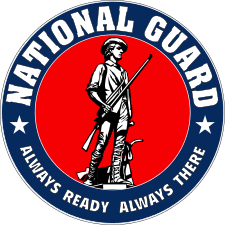 | |
| Origin | 1993 |
|---|---|
| Authorities | Title 10 (Armed Forces); Title 32 (National Guard); National Defense Auth. Act |
| Countries | 65 |
| CCMDs | USEUCOM; USOUTHCOM; USAFRICOM; USCENTCOM; USNORTHCOM; USPACOM; |
| Expenditures | $4.5M(2011)[1] |
| Events | 300+ |
| ISAF Nations | 22[2] |
| ISAF Troops | 7839[3] |



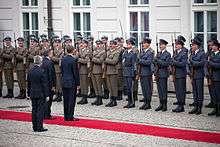






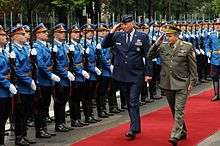
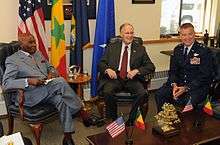
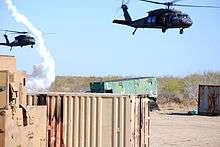
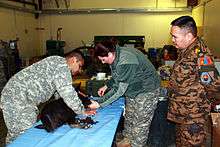

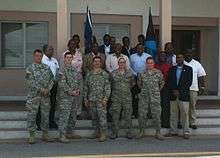


The National Guard State Partnership Program (SPP) is a United States Department of Defense program managed by the National Guard that links U.S. States with partner countries around the world for the purpose of supporting the security cooperation objectives of the geographic Combatant Commands (CCMDs).[4] By linking U.S. states with designated partner countries, the SPP aims to promote access, enhance military capabilities, improve interoperability and enhance the principles of responsible governance.[5] Furthermore, the SPP aims to support several areas of potential interest to the US Congress, such as:
- helping prevent failed states and creating stable regions
- improving the capabilities of partner nations to protect their citizens
- strengthening relationships to facilitate access and interoperability
- improving cultural awareness and skills among U.S. military personnel
- fostering the integration of reserve and active component forces into a "total force"
All SPP activities are coordinated through the geographic Combatant Commanders, the U.S. Ambassadors' country teams, the partner State, and other agencies as appropriate, to ensure that National Guard support is tailored to meet both U.S. and country objectives. Specifically, all activities must support the Theater Campaign Plan (TCP) as well as individual U.S. Ambassador mission plans in the countries where they operate.[6] The unique civil-military nature of the National Guard allows active participation in a wide range of security cooperation activities, such as:[7]
- emergency management and disaster response
- border and port security
- leadership and NCO development
- medical capacities
- economic security
- natural resource protection
- peacekeeping operations
- counter trafficking
- counter proliferation
- counter terrorism
History
As the Soviet Union disintegrated between 1989 and 1991, U.S. government officials explored options to minimize instability and encourage democratic governments in the former Soviet bloc nations. One effort to address these policy goals was to expand military-to-military contacts with the newly independent states of Central and Eastern Europe to promote subordination to civilian leadership, respect for human rights, and a defensively oriented military posture. At the time, most of these newly independent states had militaries that were based on the Soviet model and focused on countering threats from NATO nations.[8]
Sparking the program was a request from the Latvian government for help in developing a military based on the National Guard’s citizen-soldier model. Army Gen. Colin Powell, chairman of the Joint Chiefs at the time and Army General John Shalikashvili, then European Command (EUCOM) commander, embraced the concept as a way to build partnerships with non-NATO countries in the region as they established democratic governments and market economies.[9]
The United States EUCOM took the lead in this effort by establishing the Joint Contact Team Program (JCTP) in 1992. The JCTP was originally composed of active component personnel and included members of the special forces because of their language skills. However, when the JCTP began to engage the Baltic nations of Latvia, Estonia, and Lithuania, senior defense officials insisted that National Guard and Reserve personnel play a leading role in any military liaison teams operating in those countries, apparently in response to those governments’ desire to establish reserve-centric defense establishments and to assuage Russian concerns about U.S. expansion into its former satellites.[10] “The U.S. was trying to engage with the former communist nations that were in the Warsaw Pact, and using active duty troops might have been a little too offensive to the Russians or the folks that were in there, so the idea was to use the small footprint of National Guard troops,” said Air Force Col. Joey Booher, Chief of International Affairs for the National Guard Bureau.[11]
In November 1992, Lieutenant General John Conaway, the Chief of the National Guard Bureau, and Brigadier General Thomas Lennon, head of the JCTP, visited the Baltics. A few months after their trip, in early 1993, the National Guard initiated the first state partnerships: Maryland-Estonia, Michigan-Latvia, and Pennsylvania-Lithuania. Additional partnerships were proposed later in 1993 for Albania, Belarus, Bulgaria, the Czech Republic, Hungary, Kazakhstan, Romania, Poland, Slovakia, Slovenia, and Ukraine. The SPP assisted the JCTP by providing additional personnel, funding, and access to military personnel from U.S. ethnic-heritage communities who often had relevant language and cultural skills.[12]
Today, 50 U.S. states, two territories, and the District of Columbia are partnered with 65 countries around the world. Two bilateral relationships also exist between NGB and Israel and between Minnesota and Norway.[13]
Current partnerships
The State Partnership Program consists of 65 State/Country partnerships within the six combatant commands. The following is a list of each relationship with the year they were formed in parenthesis.[14]
Note: USNORTHCOM currently maintains one SPP relationship; Rhode Island / Bahamas (2005)
| USEUCOM | USSOUTHCOM | USAFRICOM | USPACOM | USCENTCOM | |
|---|---|---|---|---|---|
|
|
|
|
|
Benefits of the SPP
In a U.S. Government Accountability Office (GAO) Report to Congressional Committees published in May 2012, State Partnership Program stakeholders, including State Partnership Program Coordinators, Bilateral Affairs Officers, and Combatant Command officials, cited benefits of the program as follows:[15]
| State Partnership Program Coordinators | Bilateral Affairs Officers (BAO) | Officials from combatant commands | ||
|---|---|---|---|---|
|
|
|
Steps to new partnerships
- Nation requests participation through U.S. Ambassador
- U.S. Ambassador endorses request to the Combatant Commander
- CCMD ensures partnership request fits U.S. goals and strategy as well as availability of funds
- Combatant Commander requests state nomination from Chief of the National Guard Bureau (NGB)
- Chief, NGB, nominates the State to Combatant Commander
- Combatant Commander endorses nomination with memos to U.S. Ambassador and Chief, NGB
- Partnership interaction begins
Statutory authority
The SPP has no dedicated statutory authority; rather, SPP activities are currently carried out under one or more Title 10 (Armed Forces), Title 32 (National Guard) and National Defense Authorization Act authorities that are related to the types of missions conducted. The main authorities that may be used by SPP are:[16]
- 10 U.S.C. 168 (Military-to-military contacts and comparable activities) This provision provides authority for the Secretary of Defense to fund military-to-military contacts “that are designed to encourage a democratic orientation of defense establishments and military forces of other countries.”
- 10 U.S.C. 1051 (Bilateral or Regional Cooperation Programs). This provision authorizes the Secretary of Defense to pay the travel, subsistence, and similar personal expenses of defense personnel of developing countries in connection with their attendance at a bilateral or regional conference, seminar, or similar meeting, with certain restrictions.
- 10 U.S.C. 1050 (Latin American Cooperation). Section 1050 is similar to Section 1051, but specifically applies to the travel, subsistence, and special compensation of officers and students of Latin American countries and other expenses that the Secretary considers necessary for Latin American cooperation.
- 10 USC 1050a (African Cooperation). Section 1050a is nearly identical to Section 1050, except that it applies to officers and students of African nations.
- 10 U.S.C. 2010 (Combined Exercises). This provision authorizes the Secretary of Defense, after consultation with the Secretary of State, to pay incremental expenses incurred by a developing country as a direct result of participation in bilateral or multilateral military exercises.
- 10 U.S.C. 401 (Humanitarian and Civic Assistance). This provision authorizes DOD to carry out humanitarian and civic assistance activities in host nations in conjunction with military operations, if the activities promote the security interests of both nations and benefit the operational readiness skills of participating armed forces personnel.
- 10 U.S.C. 2561 (Humanitarian Assistance). This provision authorizes the expenditure of humanitarian assistance funds for the transportation of humanitarian relief and other humanitarian purposes.
- 10 U.S.C. 2249c (Regional Defense Combating Terrorism Fellowship Program (CTFP), which authorizes the use of funds to pay the costs associated with the attendance of foreign military officers, ministry of defense officials, or security officials at U.S. military educational institutions, regional centers, conferences, seminars, and at civilian venues, or other training programs conducted under the CTFP.
- National Defense Authorization Act, Section 1206 – funding authority for events related to Building Partnership Capacity.
- Cooperative Threat Reduction Program – funding related to preventing weapons proliferation and other activities.
For SPP events conducted overseas, National Guard members are placed in a duty status by orders issued under the authority of 10 U.S.C. 12301. For SPP events conducted within the United States, National Guard members are placed in a duty status by orders issued under 32 U.S.C. 502. This permits the participating members to receive appropriate military pay and benefits.
Funding mechanisms
Current funding for SPP activities includes the pay and allowances for the National Guard participants, which are normally funded by the Army and Air National Guard Personnel accounts of DOD appropriations. However, those who serve overseas full-time in support of the program have their pay and allowances covered by the active component Army or Air Force Personnel account. Other significant costs for SPP are travel-related expenses, such as transportation, lodging, and meals. These expenses may be incurred by National Guard personnel or foreign military personnel participating in an SPP event. Such travel-related expenses are typically paid for out of one of the Operations and Maintenance (O&M) accounts, although some of the travel expenses for National Guard personnel may be paid out of Personnel accounts. This O&M funding has historically flowed to SPP through a number of programs and activities:[17]
- Traditional Combatant Commander’s Activities (TCA)
- National Guard Bureau’s International Affairs Division
- Combatant Commander’s Initiative Fund (CCIF)
- Warsaw Initiative Fund/Partnership for Peace (WIF/PfP)
- Combating Terrorism Fellowship Program (CFTP)
- Cooperative Threat Reduction Program (CTR)
- Asia-Pacific Regional Initiative Fund (APRI)
- Latin American Cooperation (LATAM COOP)
- Overseas Humanitarian, Disaster, and Civic Assistance (OHDCA)
- Minuteman Fellowship (MMF; no longer in existence)
- Building Partner Capacity (BPC)
- Overseas Humanitarian Assistance (OHA)
References
- ↑ "Report to Congressional Committees: STATE PARTNERSHIP PROGRAM" (PDF). United States Government Accountability Office. Retrieved 13 February 2013.
- ↑ "SPP Nations Contributing to ISAF" (PDF). ISAF. Retrieved 13 February 2013.
- ↑ "SPP Nations Contributing to ISAF" (PDF). ISAF. Retrieved 13 February 2013.
- ↑ "State partnership program emphasizes building relationships". U.S. Army. Retrieved 24 October 2012.
- ↑ "National Guard State Partnership Program". EUCOM SPP. Retrieved 24 October 2012.
- ↑ "National Guard State Partnership Program". U.S. European Command. Retrieved 24 October 2012.
- ↑ "SPP Critical Areas". U.S. European Command. Retrieved 24 October 2012.
- ↑ "Use of Active Duty Troops in the SPP". U.S. Department of Defense. Retrieved 24 October 2012.
- ↑ "Eucom's State Partnership Program Becomes Global Model". U.S. Department of Defense. Retrieved 24 October 2012.
- ↑ Lawrence Kapp, Nina M. Serafino (15 August 2011). Congressional Research Service (PDF). The National Guard State Partnership: 2–3 https://fas.org/sgp/crs/misc/R41957.pdf. Retrieved 24 October 2012. Missing or empty
|title=(help) - ↑ "Use of Active Duty Troops in the SPP". U.S. Department of Defense. Retrieved 24 October 2012.
- ↑ "Use of Active Duty Troops in the SPP". U.S. Department of Defense. Retrieved 24 October 2012.
- ↑ "NG State Partnership Program Emphasizes Building Relationships". Army National Guard. Retrieved 24 October 2012.
- ↑ "The National Guard State Partnership Program". The National Guard. Retrieved 24 October 2012.
- ↑ U.S. GAO (May 2012). "STATE PARTNERSHIP PROGRAM" (PDF). Report to Congressional Committees: 10.
- ↑ Lawrence Kapp, Nina M. Serafino (15 August 2011). Congressional Research Service (PDF): 9–11 https://fas.org/sgp/crs/misc/R41957.pdf. Missing or empty
|title=(help) - ↑ Lawrence Kapp, Nina M. Serafino (15 August 2011). Congressional Research Service (PDF): 9–11 https://fas.org/sgp/crs/misc/R41957.pdf. Missing or empty
|title=(help)
External links
News articles
- The National Guard Bureau SPP Website
- The National Guard Bureau SPP News Archives
- EUCOM SPP Website
- Department of Defense SPP News Article
- Army National Guard SPP News Article
- U.S. Army SPP News Article
News videos
- The National Guard State Partnership Program: 20 Years Later
- NGB Presentation on the SPP
- Senate Armed Services Committee discusses the importance of the SPP
- EUCOM Commander talks about National Guard SPP
- Prince Faisal talks about the Jordan/Colorad partnership SPP
- South Dakota-Suriname
- Minnesota-Croatian
- New Hampshire-El Salvador
- Ohio-Serbia
- North Dakota-Ghana
- Oregon-Bangladesh
- Missouri-Panama
- Colorado-Jordan
- New York-South Africa
- Alaska-Mongolia
- Washington-Thailand